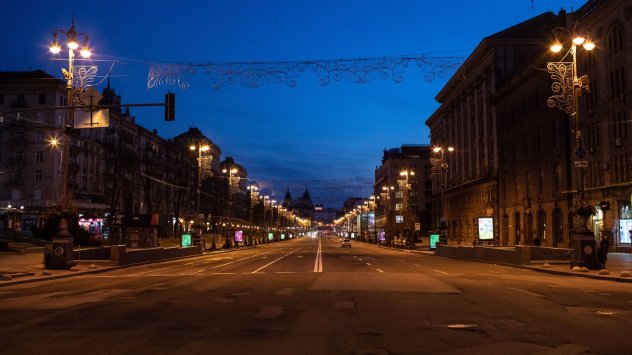
By Martin Tabakov
" If the world were flat, probably the past year 2022 would never be what it was: bend over backwards, rough, nervous and bloody," commented Thomas Friedman. "A year in which the persistence and deterrence mechanisms that keep international relations in a manageable order were once again compromised".
The result is obvious: the world is decomposing, break down into its components. But this is not the decentralization desired by liberal democracy; it is a particularization in which different tribalisms are in conflict and fighting with each other. Therefore, conflicts become an automatic problem-solving reflex. There was even talk of using tactical nuclear weapons, and this time the usual suspects were not Pakistan and India.
But the worst thing is that we do not know if the past 2022 was not just an introduction to the conflict resolution of our time. Even more: the feuds run on over a calendar which is not necessarily Gregorian. As we have seen, they do not recognize borders - neither state nor time. And technology makes it so that not only the reasons for conflicts but also the means to be used in them increase.
Terry Pratchett wrote that "time is a drug: too much of it kills you". It is the same, we can say, with conflicts. And the current year - if we judge from the previous twelve months - promises us more of them.
Nothing new on the eastern front. The past year witnessed the biggest military conflict on European territory since the Second World War: Russia's war against Ukraine. However, it did not develop according to Moscow's expectations. We saw this when the Russian offensive against the capital Kiev was suspended, and Vladimir Putin subsequently announced a partial military mobilization, with the help of which additional Russian forces were sent to the Ukrainian front.
However, the most indicative of the development of the war was the Ukrainian counteroffensive, mainly in two directions: Kharkov and Kherson. However, Russian forces demonstrate greater resilience on the Donbas front, where there is no significant change in the positions of the two warring parties. The fighting along the Dnieper River also began to take on a more positional character.
What mediated to the greatest extent the success of the Ukrainian counteroffensive was the increase in range and accuracy of the artillery used by Kiev. Its exploitation compromised Russia's supply lines, making them much more vulnerable and insecure. Precisely because of this, Moscow was unable to hold the city of Kherson and was forced to withdraw to the eastern bank of the Dnieper. However, this success of Ukraine would hardly have been possible if the country had not received military supplies from a number of countries, but mostly from the USA.
According to data from the State Department last year, Washington provided Ukraine with 236 artillery systems: one hundred and forty-two 155-meter M777A2 howitzers, thirty-six 105-meter howitzers, 38 HIMARS rocket launchers and twenty 120-mm mortars. Great Britain sent M270 MLRS rocket launchers. Despite the fact that Ukraine received air defense systems - S -300 from Slovakia, NASAMS from the USA and Norway, Iris - T from Germany - Russia successfully subjected the energy infrastructure of the country to intensive strikes. With this, the regime in Moscow only aims to make winter even more difficult for Ukrainians.
If through it - for reasons beyond control - it is expected that the intensity of the conflict will be reduced to a positional one, with the passing of the severe atmospheric conditions, it will probably intensify again. Furthermore, the war is no longer fought only where it would be convenient for the Russian forces. The lack of consensus between Kiev and Moscow regarding the main parameters that would make peace talks possible also suggests that what is happening in Ukraine in the current year of 2023 will also be one of the hottest points.
Northern Syria as a Turkish fatherland
After the attack in Istanbul in November last year, for which the authorities in our southern neighbor blamed the Kurdistan Workers' Party (PKK) and its regional affiliates, Turkey initiated Operation "Claw - Sword". It was in response to the terrorist act in the city of Bosphorus and consisted mainly of striking PKK targets in northern Syria and northern Iraq. But President Recep Tayyip Erdoğan said that this operation could also find its land expression, and not be limited only to aerial bombardments.
At least three targets - Tell Rifaat , Manbij and Kobani , located in northern Syria west and east of the Euphrates River - are in Ankara's sights because of the deployment of the People's Defence Forces (PDF), the PKK's local branch. Turkey's desire is double-natured: to widen the buffer between itself and the Kurds, thereby limiting access to its territory through the Syrian one, and to further hamper Kurdish logistics lines across the Euphrates River.
For this purpose, three years ago, Russia and Turkey reached an agreement, according to which the PDF had to withdraw to a depth of 30 km from the border with Turkey. Along the line in question, joint Russian-Turkish patrols were also established, although the frequency of their activity decreased significantly in the past 2022.
However, for the possible expansion of Ankara's military activity towards the territory of Northern Syria, there would also be purely political considerations, and not only those concerning the national security of Turkey. This year is an election year for our southern neighbor, as there will be a vote for the Mejlis and for the president. And a new and larger-scale operation against the PKK and its branches would bring certain advantages to those in power in the country. For once, this would disarm criticism from the opposition, which largely also supports military action against the Kurds. For the second time, a new operation will complicate the interaction in the opposition of Recep Tayyip Erdogan, to the extent that it consists not only of nationalists, but also of Kurds. The third time, as the experience of the previous cases of Turkish military activity on Syrian territory shows, especially when they are given a patriotic narrative in the government-controlled media, it will lead to an increase in the approval rating of Recep Tayyip Erdogan.
A new Turkish operation would certainly become a problem for Ankara's already complicated relations with both Washington and Iran. But there are serious arguments for its implementation in the current 2023 - although not necessarily noble ones.
Taiwan: US radars and Chinese fighter jets
House Speaker Nancy Pelosi visited Taiwan last August , China responded by conducting air and naval exercises around the island. Subsequently, Beijing also imposed trade sanctions on Taipei, suspending the import of some fruits and fish from the island, as well as the export of quartz sand to it (from the processing of this raw material, silicon is obtained, which is necessary for the manufacture of semiconductors).
Taiwan is a world leader in manufacturing. And given their role in modern technology - from consumer to military - China's increased pressure on Taiwan also takes on new meaning. The question is no longer just the political future of the island, but also that of its industrial base, which is of global importance. Against this background, within the chip framework of the 20th Congress of the Chinese Communist Party (CCP) held afterwards , President Xi Jinping said that when it comes to the country's reunification with the island, China has never ruled out the use of force. The latter, of course, conflicts with the policy of "One China" (as understood by the US), according to which the unification between China and Taiwan must meet two basic conditions : it must be peaceful and according to the mutual consent of Beijing and Taipei. At the same time, however, in the past year, US President Joe Biden has stated several times that if Beijing invades Taipei, Washington will defend the island militarily. These words of the head of the White House were defined by the Chinese authorities as contradicting the "One China" policy, according to which Washington recognizes that there is only one China on both sides of the Taiwan Strait.
A meeting was subsequently held Indonesia between Joe Biden and his Chinese counterpart Xi Jingping, the tension between Washington and Beijing seemed to be quelled. The two heads of state agreed to resume lines of communication, some of which were suspended earlier in the year. The latter is also important in the context of Taiwan: having a direct and fast connection between the US and Chinese administrations would be important, especially if a military incident were to occur in the Taiwan Strait.
But as we have seen in the past 2022, the situation in the region is charged with enough tension that it can erupt at any moment. Especially if Chinese fighter jets continue to enter Taiwan's anti-aircraft identification zone and Taipei monitors them with American radars (last year the State Department approved the sale of $1.1 billion worth of radar systems and missiles to the island).
For Kim Jong-Un, every day is a New Year
In the past twelve months, North Korean leader Kim Jong Un has fired more missiles than his father and grandfather combined. Among them was the new intercontinental Hwasong-17, called the "monster". Two other North Korean missiles flew over Japan, one also crossed the sea border between North and South Korea. And Pyongyang's seventh nuclear test could happen at any moment.
Whenever North Korea starts operating its missiles, the country in question has something to say to friends and foes alike. When it comes to the former, Pyongyang usually hints to China and Russia that the protection of the country from sanctions under the UN Security Council is not sufficient recognition of the merits of the North Korean regime in its opposition to the US, South Korea and Japan. That said, economic aid is also needed, especially as Pyongyang closes its border - and main trade artery - with China over covid-19. And with regard to its enemies, those same Washington, Tokyo and Seoul, Pyongyang is much more prosaic when it has its hand on the trigger: every missile fired is a warning to them.
Two events in North Korea's regional environment seem to define Kim Jong Un's irritability and his missile choreography. One is that in the past year, the presidential administration in South Korea has changed, and the previously liberal policy has been replaced by a conservative one, led by Yoon Suk Yul. This change means that Seoul will once again begin to shape its foreign policy towards Pyongyang through the lens of security. The latter has two direct manifestations: affirming and expanding South Korea's partnership with the United States and "betting" on sanctions rather than economic incentives when it comes to Seoul's diplomacy with Pyongyang. The other event in North Korea's regional environment, which also raises the dictatorial wrath of Kim Jong Un, is the resumption of military exercises between South Korea and the US. There should also be no doubt about how Pyongyang perceives Japan's increased bilateral military cooperation, either with Australia or with the Philippines.
Unlike the previous Blue House leader, Yoon Suk Yul will show less understanding of his Northern counterpart's sentiments, including Kim Jong Un's habit of lighting up East Asian skies with fireworks. The South Korean president, including because of problems of an internal political nature, cannot afford to appear weak. And this means that an escalation of tensions on the Korean Peninsula this year would not surprise anyone.
The world is big and conflicts hide everywhere
The fact that here we have highlighted several topos in which high degree temperatures are available does not at all mean that the conflict dynamics in the current year will be limited only to them. Sparks fly in many places and we just can't be sure which one might start a fire at any given moment.
Despite the signed truce between the Ethiopian federal government of Abiy Ahmed and the northern region of the country Tigray , implying the disarmament of the fighters of the Tigray People`s Liberation Front (TPLF), the clauses in the agreement are so humiliating for the latter that a resumption of the conflict would not be excluded .
In the Sahel, France's role as a security donor continues to decline, including at the expense of the Russian private military company Wagner, which is not a recipe for peace. There are many and well-known reasons for tension between Morocco and Algeria, it remains only to specify the occasion - whether it will be Western Sahara or Israel, or both.
The charge of conflict between Kyrgyzstan and Tajikistan is also persistent, and last year the Collective Security Treaty Organization (CSTO) failed to convince us of its capacity to contain conflicts between its members.
However, each of these conflicts would seem marginal if there were to be clashes between the Indians and the Chinese in the Himalayas again. An incident in the South China Sea or the East China Sea between some of the littoral countries has also long been no mere hypothetical plot.
But things are more complicated than that. Rather, it seems that conflicts and tensions neither take the same shape nor move along well-trodden paths. And again, the past year 2022 was indicative of this. Along with the war in Ukraine, statements related to the geographical parameters of the "Russian peace" were heard in the Russian public space, which made Kazakhstan, which in any case did not recognize the annexation of the occupied Ukrainian regions to Russia, cringe. Iran, on the other hand, dissatisfied with some "ricochets" of Baku's victory against Yerevan in the conflict in Nagorno-Karabakh, initiated demonstrative military training on its border with Azerbaijan.
In the Euro-Atlantic space, things are not necessarily clear-cut either. France, for example, snarled at Germany because the latter, in addition to increasing the price of electricity, provided €200 billion in compensation for German citizens and businesses. With the same argument - that it distorts the free market and the equality of its subjects - the EU expressed its displeasure with the subsidies and concessions in the tax burden that the USA provided for a number of its own productions.
All this comes to show that 2022 forsake enough problems to the current year, but not necessarily their solutions. And this means that the degrees will be high again, because the world - with or without covid-19 - has a temperature.



